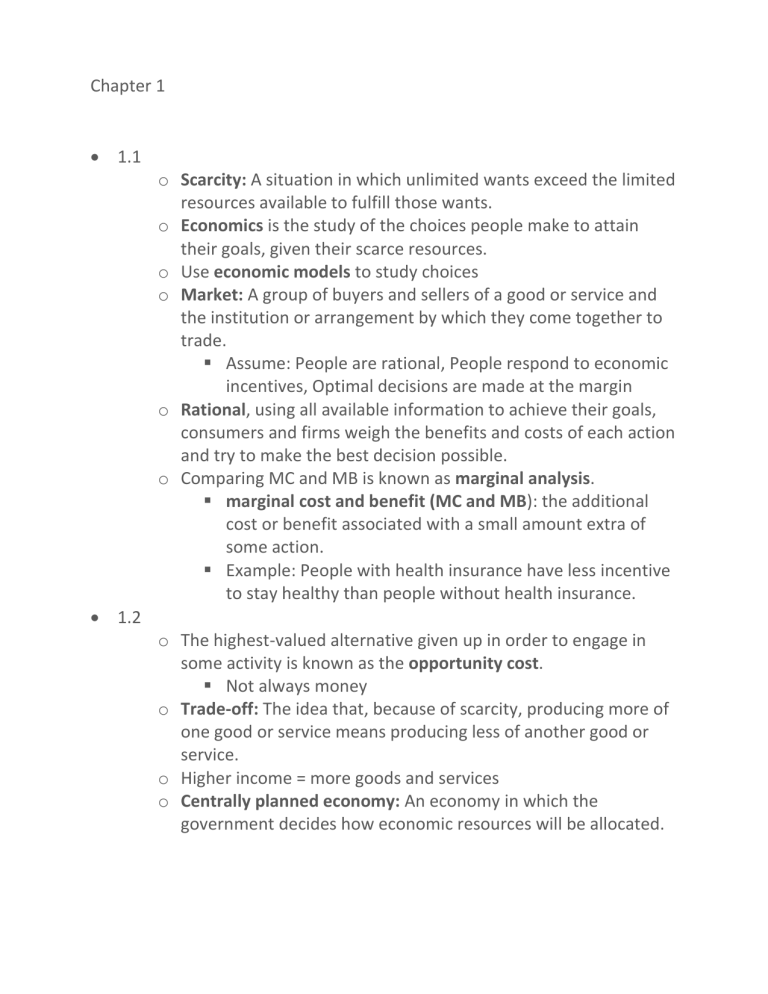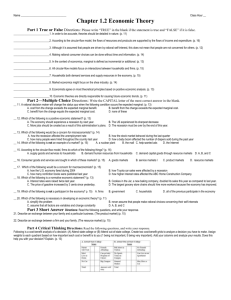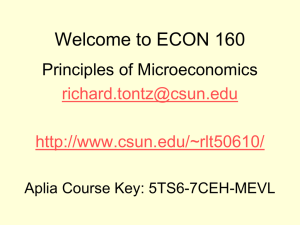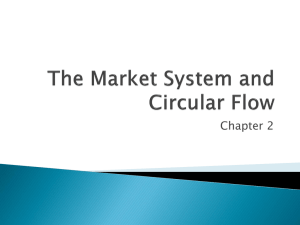
Chapter 1 1.1 o Scarcity: A situation in which unlimited wants exceed the limited resources available to fulfill those wants. o Economics is the study of the choices people make to attain their goals, given their scarce resources. o Use economic models to study choices o Market: A group of buyers and sellers of a good or service and the institution or arrangement by which they come together to trade. Assume: People are rational, People respond to economic incentives, Optimal decisions are made at the margin o Rational, using all available information to achieve their goals, consumers and firms weigh the benefits and costs of each action and try to make the best decision possible. o Comparing MC and MB is known as marginal analysis. marginal cost and benefit (MC and MB): the additional cost or benefit associated with a small amount extra of some action. Example: People with health insurance have less incentive to stay healthy than people without health insurance. 1.2 o The highest-valued alternative given up in order to engage in some activity is known as the opportunity cost. Not always money o Trade-off: The idea that, because of scarcity, producing more of one good or service means producing less of another good or service. o Higher income = more goods and services o Centrally planned economy: An economy in which the government decides how economic resources will be allocated. o Market economy: An economy in which the decisions of households and firms interacting in markets allocate economic resources. o Mixed economy: An economy in which most economic decisions result from the interaction of buyers and sellers in markets but in which the government plays a significant role in the allocation of resources., feature both o Market: a group of buyers and sellers of a good or service and the institution or arrangement by which they come together o Productive efficiency, where goods or services are produced at the lowest possible cost o Allocative efficiency, where production is in accordance with consumer preferences; in particular, every good or service is produced up to the point where the last unit provides a marginal benefit to society equal to the marginal cost of producing it. o Voluntary exchange: A situation that occurs in markets when both the buyer and the seller of a product are made better off by the transaction, both buyer and seller better off o Markets may not result in fully efficient outcomes. For example: People might not immediately do things in the most efficient way Governments might interfere with market outcomes Market outcomes might ignore the desires of people who are not involved in transactions – ex: pollution o Economically efficient outcomes may not be the most desirable. Markets result in high inequality; some people prefer more equity, i.e. fairer distribution of economic benefits o Equity: The fair distribution of economic benefits. o An important trade-off for a government is that between efficiency and equity. 1.3 o Economic variables: something measurable that can have different values, such as the incomes of doctors. o Testability: good models generate testable predictions, which can be verified or disproven using data. 2 o Assumptions and simplifications: every model needs them in order to be useful. o Positive analysis: analysis concerned with what is o Normative analysis: analysis concerned with what ought to be economists mostly perform positive analysis 1.4 o Microeconomics is the study of how households and firms make choices, how they interact in markets, and how the government attempts to influence their choices o Macroeconomics is the study of the economy as a whole, including topics such as inflation, unemployment, and economic growth 1.5 o Technology: the processes a firm uses to produce goods and services o Capital: manufactured goods that are used to produce other goods and services o Demand curve: as price decreases, demand increases o Correlation vs causation o Percent change: new – old over old *100 Chapter 2 2.1 o Scarcity requires trade-offs. Economics teaches us tools to help make good trade-offs. o Production Possibilities Frontier (PPF) is a curve showing the maximum attainable combinations of two goods that can be produced with available resources and current technology Positive (what can be produced) Points below line are inefficient 3 Points above are not attainable with current resources Opportunity cost: The highest-valued alternative that must be given up to engage in an activity. Must give up [x] in order to produce [x] more Not always linear o Not all resources are suited for production of all products The more resources already devoted to an activity, the smaller the payoff to devoting additional resources to that activity. Economic growth: the ability of the economy to increase the production of goods and services Extends ppf outward Change of shape is a technological change in industry 2.2 o Trade: The act of buying and selling. benefit from trade, by specializing in what you are relatively good at go above ppf line o Absolute advantage: The ability of an individual, a firm, or a country to produce more of a good or service than competitors, using the same amount of resources. o Comparative advantage: The ability of an individual, a firm, or a country to produce a good or service at a lower opportunity cost than competitors BASIS OF TRADE 2.3 o A market is a group of buyers and sellers of a good or service, and the institution or arrangement by which they come together to trade. o Households consist of individuals who provide the factors of production: labor, capital, natural resources, and other inputs used to make goods and services. 4 Households receive payments for these factors by selling them to firms in factor markets. o Firms supply goods and services to product markets; households buy these products from the firms. o o o o o o o o o o o Chapter 3 5 Labor: types of work capitol: used to produce goods (machine, computer etc.) natural resources: land, water, oil, ore, raw material entrepreneurial: the ability to bring together factors of production A free market is one with few government restrictions on how a good or service can be produced or sold, or on how a factor of production can be employed. Specialization is limited by the extent of the market markets will do better than centrally-planned systems for satisfying human desires because individuals are acting only in their own rational self-interest. “invisible hand” allows individual responses to collectively end up satisfying the wants of consumers. An entrepreneur is someone who operates a business, bringing together the factors of production—labor, capital, and natural resources—to produce goods and services The best entrepreneurs create products that consumers never even knew they wanted. Property rights: the rights individuals or firms have to the exclusive use of their property, including the right to buy or sell it.









